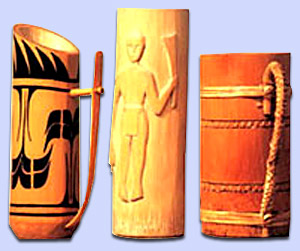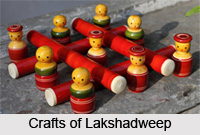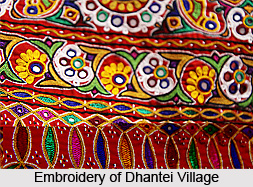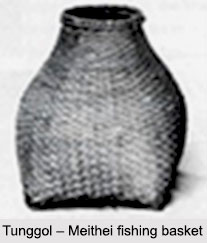 Baskets of varied shapes and sizes have been in use for the purpose of fishing, in the hills as well as in the valley of Manipur since time immemorial. The range of different baskets used for fishing by the people in the valley is much more than those used by the hill people. The baskets used for fishing purposes can be broadly classified into 2 groups: Baskets with which fish are caught, and baskets that are used to keep the caught fish. Apart from these baskets, traps and fishing rods are used for catching fish.
Baskets of varied shapes and sizes have been in use for the purpose of fishing, in the hills as well as in the valley of Manipur since time immemorial. The range of different baskets used for fishing by the people in the valley is much more than those used by the hill people. The baskets used for fishing purposes can be broadly classified into 2 groups: Baskets with which fish are caught, and baskets that are used to keep the caught fish. Apart from these baskets, traps and fishing rods are used for catching fish.
Various scholars have remarked on the fishing trade of Manipur, which helps in understanding the different types of baskets and traps used. Col. W. McCulloch, known as one of the authorities of Manipur who remained as the land"s Political Agent during the 19th century, reported in his "Account of the Valley of Munnipore and of the Hill Tribes" that the Loktak Lake is the great resort of aquatic birds and is covered with floating islands, under which, amongst the roots of the vegetation form fish in cold weather, collected in great number. These fishes were caught in the given manner: An island, having been cut into a manageable size, was pushed to a part of the lake where the water was not very deep and there the bottom had been paved with stones. There it was fixed by means of long bamboo stakes. When the fish had collected in sufficient quantity, a long strip of land sufficient to surround it was cut from other of these floating masses of vegetation. It surrounded the asylum of the fish collected, and a row of stones was placed on the edge nearest to the island, such that the edge sank down to the prepared bottom, whilst the rest remained upright in the water, thus forming a wall around. The fishes were then driven out of their sanctuary; if small, taken in nets and if large, they were separated using torchlight.
What Col. McCulloch observed during the 19th century with regard to fishing in the mighty Loktak Lake, is still in practice though modern methods have also been introduced up to a certain extent. Another great scholar, who was considered as one of the authorities in Manipur, T. C. Hodson, reported in his compilation "The Meitheis" that the Loktak was free and the price of the produce of private fisheries is regulated by the competition of the fishers of the lake. There were varying methods in use in accordance with the needs and capabilities of the different localities, with application of weirs, fishing baskets, traps, spears and nets, all showing a high degree of suitability. The women practised fishing with a square net suspended from a central pole by four strings at each corner, dipping it well under the turbid waters of the edges of lakes or ditches and slowly raising it till the catch rose above the surface of the water, smartly bringing it out.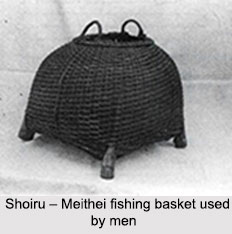
The various implements used in fishing, include the ones made of cane and bamboo, comprising baskets and traps of different shapes and designs. The women folk in the valley use a bowl-shaped basket called Long, to catch fish in shallow water. The method of use is peculiar. The Long is dipped into the water and kept near the feet with its open end towards the person. Then, the fisherwomen churn up water with both their feet, in order to scare the fish right into the open mouth of the basket. After doing this for some time, the Long is lifted out of the water with the trapped fishes. Although Longs are also made in some particular areas of the Manipur valley, the main centre of production is a place called Patsoi. The bamboo basket usually has a mouth diameter of 40.5 centimetres.
The men folk in the valley use a fishing basket called Long-oop, to catch fish in waist-deep water, the method of fishing being quick dips of these baskets into the water, keeping it rooted for a few minutes, and then a search for fish inside the basket by putting the hand into the Long-oop through a narrow opening at the upper end. The baskets used for containing the fish thus caught, usually have an elongated neck and a narrow mouth. In order to prevent the fish from leaping out of the basket, an appliance made of bamboo termed Shou, is fixed inside the neck portion of the basket. The Shou is conical in form and has a pointed tip. It is slightly blackened over the fire. It is bound firmly with fine bamboo splits. The mode of using these fishing baskets by the women folk when they go out fishing is to tie the strap attached to the basket around their waist and dangle it on their right side.
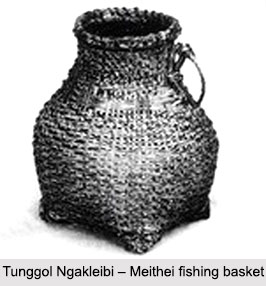 Tunggol is a Meithei fishing basket made of bamboo, 33 centimetres in length and 12 centimetres being the diameter of the mouth. Tunggol Ngakleibi is another Meithei fishing basket, with a narrower mouth of 10 centimetres diameter and a bulging body, its length being 24 centimetres.
Tunggol is a Meithei fishing basket made of bamboo, 33 centimetres in length and 12 centimetres being the diameter of the mouth. Tunggol Ngakleibi is another Meithei fishing basket, with a narrower mouth of 10 centimetres diameter and a bulging body, its length being 24 centimetres.
The men folk of Andro village use a basket with strap, called Sungtu, to contain caught fish. This particular basket has a narrow mouth, with 11 centimetres diameter and also has 4 leg stands. It stretches up to a height of 36 centimetres. The style of carrying the Sungtus is by hanging them on the shoulders. People living by the Loktak Lake who entirely depend on fishing for their livelihood, use a big basket called Cheplei Thop, for containing the fishes caught from the lake. The fishermen of Thanga, a place by the lake, use a particular basket called Longtholthop, for containing prawns caught from the lake. The basket has a wide mouth with legs. Fishermen playing on canoes, when fishing on the Loktak Lake, use a basket known as Shoiru, to contain the caught fish. The Shoiru has a narrow mouth with 17 centimetres diameter, but has a broad bottom. It has two loops or ears at the rim, for convenience in carrying the basket. The slender end of the oar is inserted into the two loops and then the oar with the laden basket dangling from it is put on the shoulders and thus carried. In the valley, earthen or mud enclosures are contrived to block off the flow of water in streams, rivulets, canals, marshes etc., and the trapped water inside the enclosures is then drained out with the help of a native appliance called Isotop. It is a trough like structure made of bamboo and attached to one end of a bamboo pole. After the water is completely drained out, the fish found in the enclosure are then taken by hand and contained.
Related Articles:
Bamboo Products of Meitheis in Manipur
Basket Weaving Techniques in Manipur
Manipur
Meithei Language
Baskets
Crafts of Manipur
Bamboo and Cane Crafts of Manipur
Bamboo Crafts in India
Fishing Industry in India
Fishery in India



